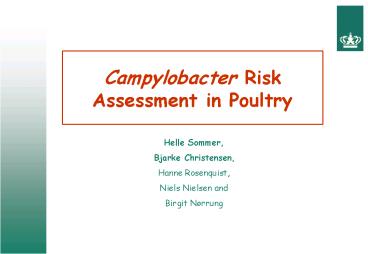VFD standard skabelon
1 / 22
Title: VFD standard skabelon
1
Campylobacter Risk Assessment in Poultry
Helle Sommer, Bjarke Christensen, Hanne
Rosenquist, Niels Nielsen and Birgit Nørrung
2
Probability of Exposure
P r e v a l e n s
Pfarmh.
SLAUGHTERHOUSE
RETAIL
CONSUMER
RISK
Ca.bleeding
C o n c e n t r a t i o n
Probability of Infection
3
Slaughter house modules
- Data examinations distributions
- Process model building explicit equations
- Explicit equations/ simulations
- Cross contamination
- What-if-simulations
4
Data examinations
- Data for 3 different purposes
- - prevalence distribution -gt slaughterhouse
program - - concentration distribution
- - model building, before and after a process
- From mean values to a distribution
- Lognormal/ normal gt illustrations
- Same or different distributions gt variance
analysis
5
From mean values to a distribution
17 log mean values from different flocks and from
2 different studies
6
From mean values to a distribution
17 distributions -gt one common distribution
7
Log-normal or normal distribution ?
True data structure simulated data
(sim.) Assumed distribution (dist.) Published
data means of 4 samples,6 means from one
study sim. lognormal(6.9,2.3) dist. normal or
lognormal
8
(No Transcript)
9
(No Transcript)
10
(No Transcript)
11
Real data set
12
New Danish data
13
Building mathematical models
Slaughterhouse process
14
Why new mathematical process models ?
15
Explicit mathematical process model
16
Explicit mathematical process model
In normal scale µy µx / ?µ 100 10000/100 In
log scale µlogy µlogx ?µ 2 4 - 2
17
Explicit mathematical process model
In normal scale µy µx / ?µ 100 10000/100 In
log scale µy µx ?µ 2 4 - 2 sy2 ß2 sx2
Transformation line y ? ßx
18
Explicit mathematical process model
Overall model µy µx - ?µ sy2 ß2 sx2 Local
model Y ? ßx
Calculation of ? ? (1-ß) µx- ?µ
19
Explicit mathematical process model
In normal scale µy / µx 158 In log scale µy
µx - 2.2
20
Explicit mathematical process model
In normal scale y x z z ? N (µ, s)
21
Summing up
- Data knowledge/logical assumptions of the
process -gt multiplicativ or additive process
- Explicit equations for modelling slaughterhouse
processes Monte Carlo simulations, modelling
each chicken with a given status of infection,
concentration level, order in slaughtering, etc.
- New data of concentration (input distribution)
-gt different or same distribution ? (mean and
shape)
22
Advantage with explicit equations
- Faster than simulations/Bootstrap/Jackknifing
- Accounts for homogenization within flocks
- More information along the slaughter line does
not give rise to more uncertainty on the output
distribution.































